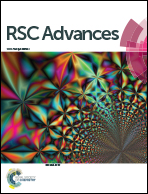Building a chimera of aptamer–antisense oligonucleotide for silencing galectin-1 gene†
Abstract
Galectin-1 is closely related with immune systems, and its overexpression may cause tumor metastasis. Owing to the better stability of antisense oligonucleotides than siRNA, we constructed a chimera of aptamer–antisense oligonucleotide (Apt–AS) for silencing the galectin-1 gene specifically. For studying the endocytosis pathways of Apt–AS by aptamer targeted delivery, we marked the 3′ terminus of Apt–AS with Alexa Flour 488 (Apt–AS488) so as to trace the pathways through the confocal microscope. Furthermore, Apt–AS was used to silence the expression of galectin-1. The results showed Apt–AS entered cells by a caveolae mediated endocytosis pathway, and the aptamer–antisense chimeras did not impair the antisense gene silencing efficiency. Moreover Apt–AS could improve the cellular uptake and selectively entered cells.


 Please wait while we load your content...
Please wait while we load your content...